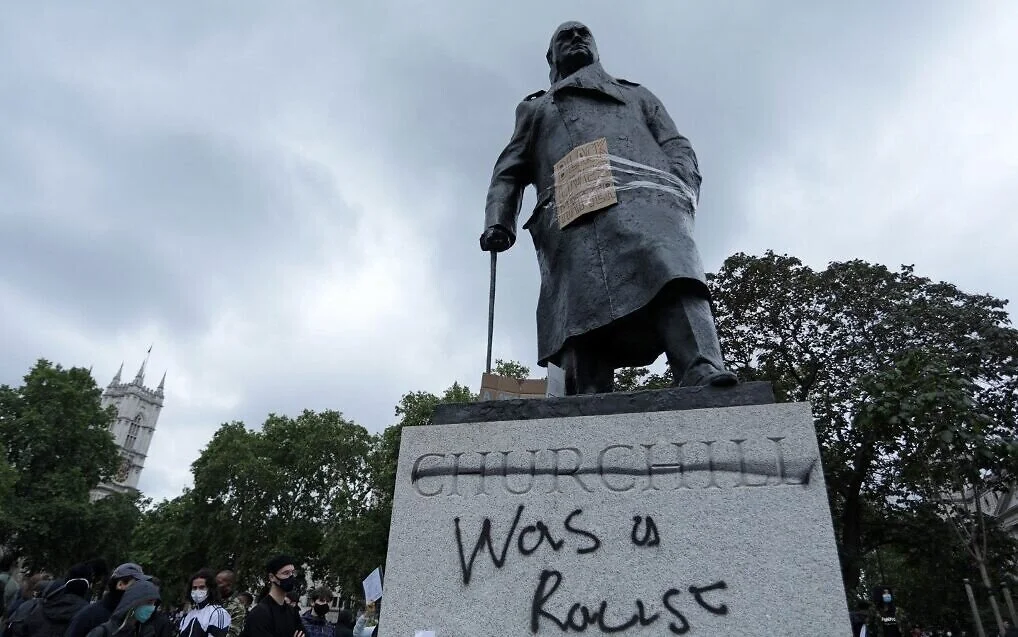Last week, Black Lives Matter protests in the UK culminated in attacks on some controversial statues and the defense of statues feared to be ‘at risk’ of damage. After some graffiti tagged Churchill as a racist, the statue on Parliament Square was quickly protected and Boris Johnson rushed to the defense of his hero.
Condemning the actions, Johnson stated that we should not censor our past and that the statue is a “reminder of his achievement in saving this country – and the whole of Europe – from a fascist and racist tyranny.” This rhetoric plays into the glory of Britain’s past and downplays the contribution of our allies in defeating the tyranny of fascism. A rhetoric which not only fed into and propagates many of the myths behind Brexit, but which goes to the very heart of the issue at hand: the British past.
Johnson admitted Churchill held some views which would be considered controversial today and asked “Would it not be better and more honest to ask our children to understand the context, to explain the mixture of good and bad in the career of Churchill and everyone else?”
So let’s talk about his past honestly. Churchill’s political career spanned 7 decades during a period that turned some conventional, long-held ideas on their heads. Yet it is fair to say that Churchill had a patchy record on women’s rights and racial equality.
Churchill was appointed Home Secretary in January 1910, just as activists in the suffragette movement were turning to militant means (led by the Women’s Social and Political Union [WSPU]), and it was he who was responsible for putting down their protest. His support for women’s suffrage was minimal at best, making him a frequent target of their militant action. And yet his views remained unchanged. He is alleged to have said: ‘The women’s suffrage movement is only the small edge of the wedge, if we allow women to vote it will mean the loss of social structure and the rise of every liberal cause under the sun. Women are well represented by their fathers, brothers and husbands.’
By the end of the First World War, following years of women’s active contribution to the economy and the war effort, the debate on women’s suffrage had come a long way. In 1918, Parliament, Churchill included, voted to grant the vote to women over the age of 30 and of certain social status. This Parliamentary act also extended the vote to all men over the age of 21, in recognition that working class men returning from the front lines could hardly be denied the vote after defending their country. Similarly, Churchill was swayed on the issue of women’s suffrage in recognition of their contribution on the Home Front.
Some argue that by the time of the Second World War, he was much more supportive of women’s rights, expanding opportunities for them to engage in the war effort. Yet, in 1944, he used his influence to reverse a vote that would have given equal pay to women teachers. Overall, his views and voting behaviour seem to have been dominated by political tactics rather than strong convictions in favour of women’s rights.
His position on empire and race is much harder to swallow. He was a staunch colonialist and even though he ‘fought the tyranny of fascism’ (and please, let’s not pretend Britain did that on its own or deny the role the British colonies played in doing so), he was against independence of Britain’s colonies and oversaw multiple abuses of power and racist acts.
He was heavily involved in the Boer War in the early 1900s, supporting the establishment of concentration camps – for both Boers and black Africans - during a war that resulted in thousands of deaths. He wrote about his hatred of Indians and was opposed to Indian Independence, as well as any concessions to their freedom. During the Second World War, he diverted food away from India, contributing to the 1943 famine that killed more than 3 million people. And, when PM for the second time, he bore overall responsibility for the brutal repression of the Mau Mau rebellion in Kenya. “Britain’s Gulag” detained between 80,000 and 320,000 people, and subjected them to systematic torture, forced labour, rape and murder. Not only has this disturbing reality been largely left out from Churchill’s narrative, the forced detention and murder of thousands of men, women and children was deliberately suppressed by the state for more than 50 years.
Finally, in the run up to the 1955 election, he proposed a campaign of “Keeping England White”, in response to growing migration from the Caribbean, stating to the governor-in-chief of Jamaica, Sir Hugh Foot, that this would create ‘a magpie society’ which ‘would never do’.
So if, as the current Prime Minister suggests, we are to avoid editing our past, we must acknowledge the negative along with the positive aspects of Churchill’s track record. Admittedly the yard stick has changed in the past 100 years. And Churchill’s career spanned a time which saw huge changes in the world order, growing social mobility and greater social justice. Perhaps the kindest thing we can say was that he was slow on the uptake.
If we really want to teach children about our past, these aspects deserve scrutiny and should not just be swept under the rug in favour of his glorifying his role in defeating Hitler. Let’s be clear, I’m not suggesting the statue be removed but proposing that we acknowledge these contradictions and use the lessons of the past to shape our values of the future. And I urge Boris Johnson to listen to his own words: “To explain the mixture of good and bad in the career of Churchill and everyone else?”


